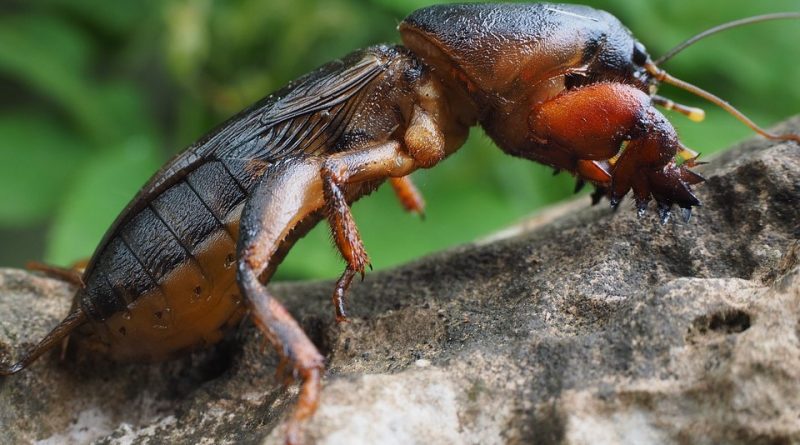Gryllotalpa gryllotalpa
Gryllotalpa gryllotalpa
The grillotalpa (Gryllotalpa gryllotalpa L., 1758) is an orthopterous insect that belongs to the Gryllotalpidae family.
Systematics –
From the systematic point of view it belongs to the Domain Eukaryota, Kingdom Animalia, Sub-Eumetazoa, Phylum Arthropoda, Subphylum Tracheata, Superclass Hexapoda, Class Insecta, Subclass Pterygota, Coop Exopterygota, Subcoorte Neoptera, Superorder Polyneoptera, Section Orthopteroidea, Order Orthoptera, Suborder Ensifera, Superfamily Grylloidea, Family Gryllotalpidae and then to the genus Gryllotalpa and to the species G. grillotalpa.
Geographic Distribution and Habitat –
Gryllotalpa gryllotalpa is an insect now common throughout Europe; some northern countries (Iceland, Norway, Finland) and Corsica are exception, where, until today, it has not been reported. We also find it in northern Africa and western Asia and is present in the eastern United States where it probably came through loads of ornamental plants.
Morphology –
Gryllotalpa gryllotalpa is an unmistakable insect due to its particular morphology. The adults are 30-40 mm long, brownish black, covered with a velvety down, and have a pronounced prothorax and two strong fossil legs, enlarged and flat and denticulated, which are used to dig numerous tunnels in the ground, damaging the roots of the plants that are sheared. The insect is able to fly, if it needs it. The front wings are short while the rear ones, more developed, are longer than the elytra. The male is provided with a stridulating organ, while the female is devoid of the external ovipositor typical of the other ensembles.
Attitude and biological cycle –
Gryllotalpa is an insect with high polyphagia and is particularly widespread in all environments; especially proliferates in gardens, gardens, nurseries and protected crops, especially in the presence of moist and loose soils.
The insect winters at the juvenile stage in the depths of the land with a cycle that is completed in 2 years. The appearance of adults takes place in the April-May period, as oviplates in rounded oottes dug into the ground at a depth of 10-20 cm, preferably in the portions of uncultivated land and with a more compact soil (eg headlands).
The neanidi are born in the summer period after about 2-3 weeks from the oviposition; these are initially looked after by the mother, and then after a few days leave the nest and become independent, digging their own galleries and starting the direct trophic activity; these nymphs then winter in depth in the ground, becoming adults in the summer of the second year but reaching sexual maturity only in the late spring of the 3rd solar year.
The containment of this insect consists in destroying the tunnels and its nests by digging the soil, especially between the end of May and throughout June. Moreover, as the wintering individuals are attracted to horse manure, this can be used to flush them out and then eliminate them. Among the chemical remedies are pyrethrum and azadirachtin (permitted in organic farming).
A method to contain the population of this insect is to encourage the presence of its natural predators, as well as to artificially spread other harmful organisms against it, such as nematodes of the genus Steinernema (in particular S. scapterisci and S. carpocapsae), the Sfuride Larra bicolor, the carabidae of the genus Stenaptinus, the Brazilian red fly Ormia depleta and some species of mushrooms, for example Beauveria bassiana and Metarhizium anisopliae. For the biological control techniques the following sheet can be consulted.
Ecological role –
The damage of this insect is due to the activity described above. In fact, the Grillotalpa is predominantly zoophagus even if it completes the diet with hypogeal plant parts; in any case it is polyphagous, feeding on a vast range of plants, of which it particularly attacks its roots; in addition to eating, the shears to dig its tunnels. For this reason the greatest damage is related to the breaking and damage of the roots and the hypogeal parts of the plants.
This insect also causes extensive damage to the grasslands of parks, sports fields and golf meadows, a situation often worsened by crows digging the grass in search of its larvae.
Guido Bissanti
Sources
– Wikipedia, the free encyclopedia.
– Russo G., 1976. Agricultural Entomology. Special Part. Liguori Editore, Naples.
– Tremblay E., 1997. Applied entomology. Liguori Editore, Naples.

